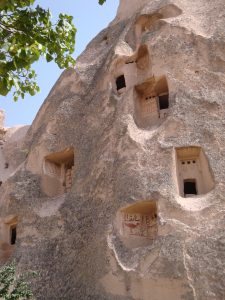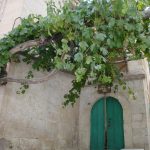Cappadocia’s “Outer Castle” Population: 3,500
“Mirror, mirror on the wall, who is the fairest of them all?” Were someone to hold a mirror up to Cappadocia and ask this question, the answer that comes back might well be “Uçhisar”, so lovely is this little troglodyte village, the first that visitors see when they leave Nevşehir to drive to Göreme.
To find out more about Uçhisar look out for Evelyn Kopp’s Uçhisar Unfolding (Çitlembik), published in 2002.
 Around town
Around town
Uçhisar is dominated by a huge plug of rock, a so-called kale (castle) which is mirrored in Ortahisar, a similar-sized village just off the road from Nevşehir to Ürgüp. Way back in history Uçhisar’s was the “outer castle” in the defences of Cappadocia. Ortahisar was the “middle castle.” Başkale, the first “castle”, was eventually renamed Ürgüp.
Mts Erciyes and Hasan aside, Uçhisar Kalesi (Uçhisar Castle) is by far the most conspicuous upstanding feature of the Cappadocian landscape. Although it’s often said that the rock of Uçhisar is called a castle because it looks like one, in reality it doesn’t look anything like the man-made castles with which most visitors will be familiar. Instead, the locals called all the jutting rock cones “kales” before the marketing people came up with the more evocative “fairy chimneys”. This kale is a solid chunk of rock with a thinner offshoot – from a distance the two parts resemble a giant snail dragging its shell across the landscape. In the past, families hollowed caves out of the rock and used them as retreats whenever enemies appeared; in more peaceful times those same caves provided homes for the locals, so that Uçhisar Kalesi functioned rather like a natural tenement block stuffed full of apartments.
In the 1950s the authorities moved residents out of the castle and into modern afet evleri (disaster houses) for fear of a landslide. They were only just in time – in the 1960s a serious rockfall caused the collapse of the Ağa’nın Konağı (the Lord’s Mansion), a palatial home that had been created inside it.
Today you can buy a ticket and climb up inside the castle to take advantage of the superb views available from the summit, all of 1,350m above sea level.
The rock formations that huddle in the wake of the kale are almost equally dramatic. Most soar above the surrounding houses, their sides pockmarked with pigeon-houses, their facades daubed with patterns in red and white pigments aimed at luring the vital, manure-supplying birds to a favoured roost.
Now it’s possible to climb up inside two of the fairy chimneys to take tea à la Cappadoce and get some impression of what it might have been like to live inside such structures. The local branch of the Jandarma has also taken up residence inside a fairy chimney. It’s just a shame that stalls selling tacky tourist souvenirs are creeping ever further in from the road, thereby encroaching on the dignity of the glorious landscape.
From the road that whisks visitors past Uçhisar and on to Göreme it can look as if all the locals live in newly built and aesthetically banal houses. However, to one side of the castle it’s still possible to stroll around and admire the ruins of the old village where fine stone houses were built over and in front of cave networks. Over the last two decaded foreigners and Turks from elsewhere in the country have moved in on these houses, converting them into houses and hotels of varying degrees of boutiqueyness. In some cases the end results are a joy to the eye – one thinks of Les Maisons de Cappadoce with their beautiful views over the Pigeon Valley, for example, of the much newer Kale Konağı or of the wonderful Argos in Cappadocia complex. But of course some developers have chosen to ignore the essentially small-scale rural charms of the vernacular architecture with the inevitable detrimental consequences to the landscape.
Sleeping
Ahbap Konağı. Tel: 0384-219 3020
Les Maisons de Cappadoce. Tel: 0384-219 2813
Kale Konağı. Tel: 0384-219 3006
Karlık Evi. Tel: 0384-219 2995
Museum Hotel. Tel: 0384-219 2220
Taşkonaklar. Tel: 0384-219 3001
Eating
Centre Cafe & Restaurant Unexpectedly delightful eatery right in the main square (Belediye Parkı) where the old town meets the new, this cafe is buried amid the trees of what looks like a traditional tea garden but turns out to be a restaurant with a pleasing mix of Turkish and international dishes. To please its large French clientele it serves decent steaks with a tendency to err on the side of undercooking – ask for yours iyi pişmiş (well cooked) if you don’t want any blood. The best dish of all doesn’t even feature on the menu and may need to be pre-ordered. It consists of pasta piled high with seafood, a rare treat so far inland. Prices slip into the mid-range but you’re unlikely to go away less than satisfied. The trees make for privacy even when there are lots of other diners. Tel: 0384-219 3117
Travel info
There are half-hourly dolmuşes from Nevşehir to the centre of Uçhisar. The half-hourly services between Nevşehir and Göreme also pass through Uçhisar, dropping people in the modern part a short walk away from the kale.
Day trip destinations

